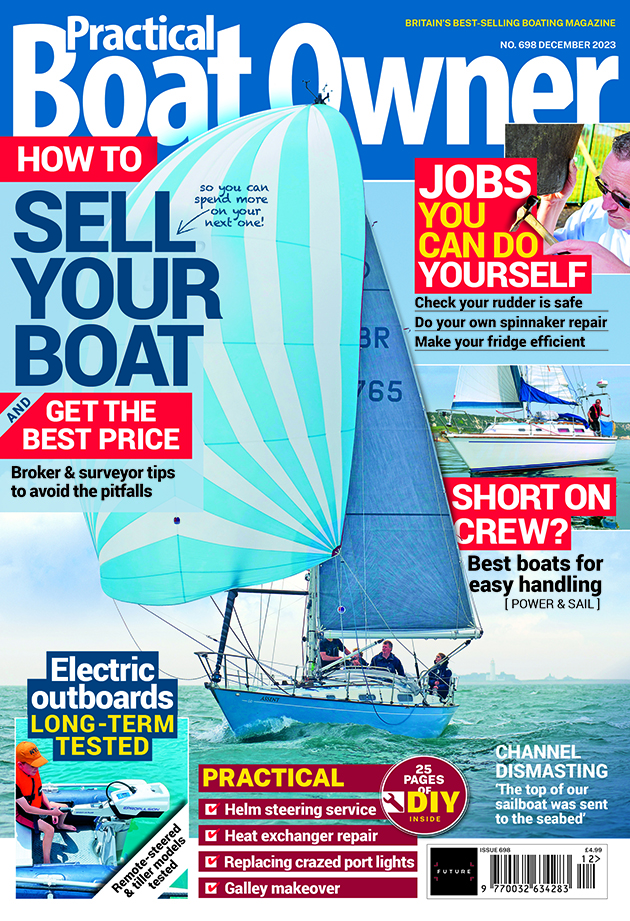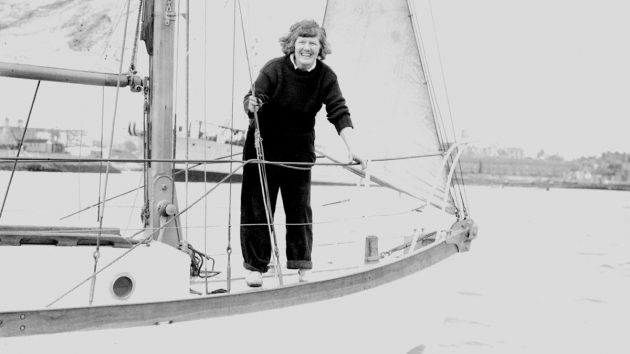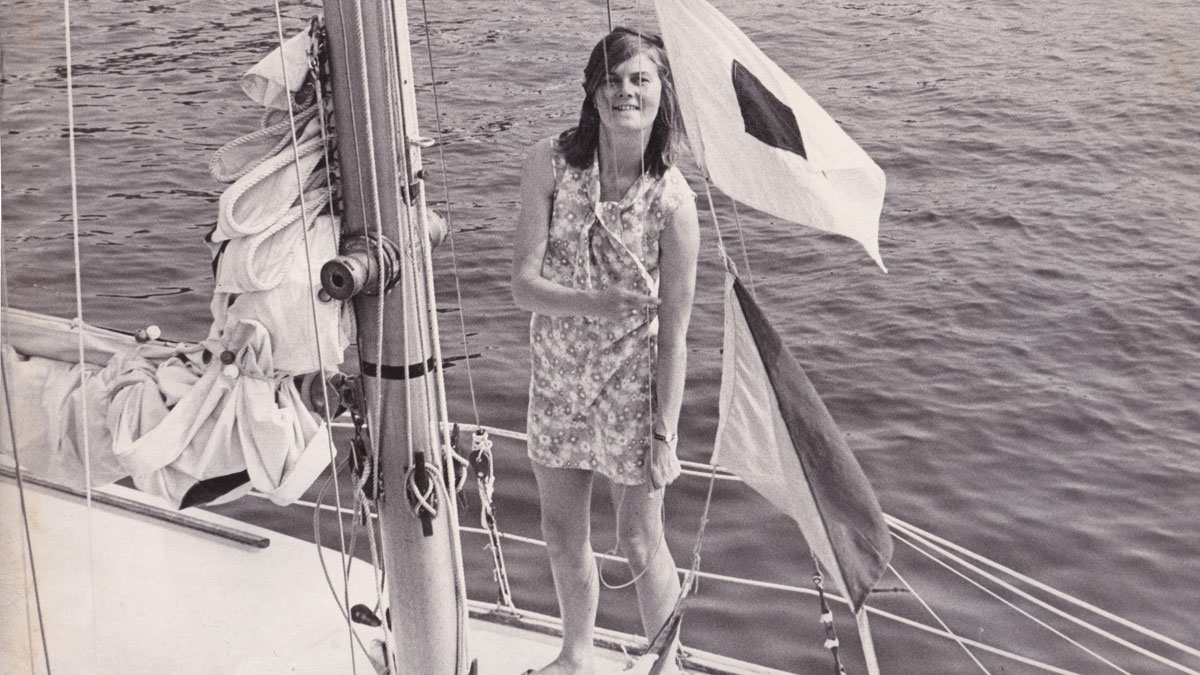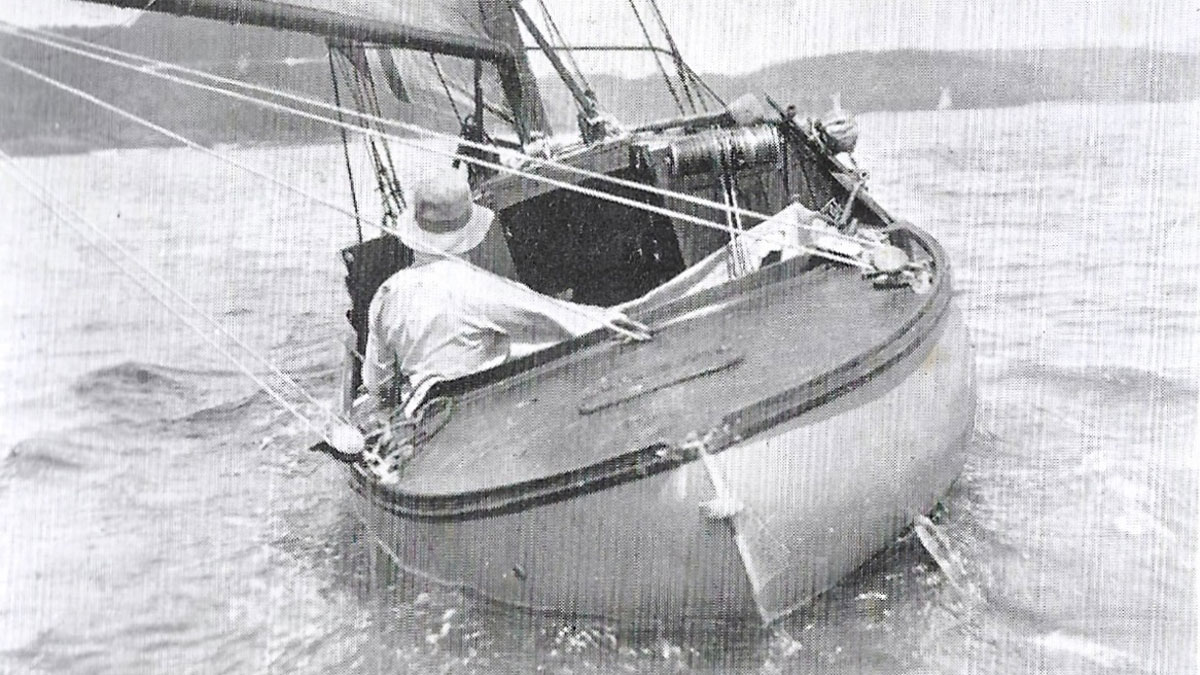Ann Davison became the first woman to sail across the Atlantic solo when she arrived in Dominica in January 1953 before sailing up to New York. Katy Stickland looks back at her record
It was a misty, drizzly November morning when Ann Davison steered Felicity Ann up the Hudson River in New York to tie up at Pier 75.
This was the end of the challenge the 40-year-old had set herself – to sail, alone from England, across the Atlantic Ocean and then to New York.
The voyage took 18 months, but along the way, Davison had become the first woman to sail across the Atlantic solo.
Although she had made history, this was not her main motivation.

Leaving Plymouth. Ann Davison originally planned to sail straight for Madeira, but gear problems led to her diverting to France. Credit: Associated Press/Alamy Stock Photo
Three years earlier, Ann Davison had lost everything: her husband, Frank, their 70ft converted fishing ketch, Reliance and the dream of a new life living in the Caribbean.
The couple had left the UK from Fleetwood bound for Cuba in May 1949 but were battered by heavy weather almost from the start; neither had the seamanship skills to sail safely through the conditions.
Reliance was also not finished, as the boat had been threatened with repossession.
19 days later, with no working engine and the “sails blown out”, Reliance was wrecked on the rocks at Portland Bill.
Both of them made it into a liferaft but it was swept out to sea by the race. Frank was killed, but Ann made it to shore, climbing the cliffs “to start life again, alone.”

In Nassau, The Bahamas, Ann Davison learned to enjoy sailing. Credit: Getty
As she admitted, fear of the sea and her need to overcome it was vital if she was “to find a key to living”; a solo passage across the Atlantic represented “life in essence”.
“If I could navigate a ship across the ocean on my own, it might be that I would be well on the way to learning how to live,” noted Davison in the book of her transatlantic voyage, My Ship is So Small.
A gifted author, Ann Davison had already written Lost Voyage, about the refurbishment of Reliance and the death of Frank, and Home was an Island, which covered the period when she and her husband had owned and farmed on the islands of Inchmurrin and then Inchfad on Loch Lomond.
The sales of both books had cleared the debts from Reliance and paid for Felicity Ann, the Sid Mashford-designed 23ft Bermudan rig sloop, built at Cornwall’s Cremyll Shipyard.
Even before Davison left Plymouth to sail across the Atlantic, she had already signed a book deal; yet another motivation to complete the voyage.
Few solo sailors are as publicly honest as Davison about the terror she felt sailing alone, which often left her “cold and lonely and frightened”.
Continues below…
The pioneering sailor you’ve probably never heard of: Nicolette Milnes Walker
Nicolette Milnes Walker was the first woman to sail solo and non-stop from the UK to the USA. Julia Jones…
Jessica Watson – the real sailor behind the True Spirit film
Whilst the new Netflix True Spirit movie was being filmed, celebrating Jessica Watson's real-life teenage solo, non-stop global circumnavigation, the…
Margaret and Frank Dye: open boat pioneers
Roger Barnes reflects on the legacy of small-boat sailors Margaret and Frank Dye
Frank Cowper: the sailor who “invented” cruising
Katy Stickland talks to Frank Cowper’s great granddaughter about the life and legacy of this unsung pioneer of yachting for…
Always yearning for adventure and the “rugged stuff”, she qualified as a commercial pilot in 1935 – one of the few women in the UK to do so – and then had gone on to farm on remote Scottish islands.
Following the death of Frank, she worked in a South Coast boatyard as a boatyard hand – “women in the boating industry being as popular as Beethoven at a jam session” – living on a 40ft boat in desperate need of a refit.
Davison was used to “uncomfortable living”.
It was her toughness and curiosity to experience sailing across an ocean solo, first hand, which beat the fear; it also gave her freedom, independence, travel and a home – all reasons which have motivated many to sail alone.
Learning to sail
Davison was taught to sail by her late husband Frank on Lake Windermere, but she still felt she “knew nothing”.
She began lessons in Tor Bay, Devon with Commander Lund, who had spent 20 years teaching navigation in the Royal Navy.
Sailing his 18-foot yawl taught her how to handle a small boat; she also learned how to calculate tides and plot a course using celestial navigation (a skill Davison always found tricky as although she understood the essentials, she couldn’t add up).
It was Commander Lund who found Felicity Ann.
Initially, Davison thought the boat was “too small” and she had doubts it would handle heavy weather offshore, but “the price was right” and she felt an instant connection with the vessel.

It took three months to refit Felicity Ann for the Atlantic Crossing, including making the cockpit watertight and self-draining and fitting a sprayhood. Credit: Getty
It took three months to fit out Felicity Ann.
Ocean Cruising Club founder Humphrey Barton, who at the time was working for Laurent Giles, surveyed the attractive tiller-steered double-ender and suggested modifications ahead of an Atlantic crossing including new rigging, reducing the mast by 6ft and the boom by 8 inches to accommodate a smaller sail plan, which included twin stay-sails for running downwind, strengthening of the coachroof with steel straps and fitting a sprayhood, high steel stanchions, a pushpit, a watertight and self-draining cockpit, and a new 25-gallon water tank.
While the work was being carried out, news of Davison’s plans to sail solo from Plymouth to Madeira and then across the Atlantic to Antigua became public.
Soon she had signed contracts with Life magazine and the Sunday Chronicle, and just like solo female skippers today, Davison found herself under the intense scrutiny of the mainstream press.
Luckily, American Norman Fowler and experienced solo sailor Edward Allcard were also in Plymouth preparing to sail Fowler’s Catania home to America; it took the press heat off at times.
Pushed to the limits
On 18 May 1952, Ann Davison sailed out of Plymouth Sound into the English Channel “afraid and lonely”.
Just 230 miles later, Felicity Ann was being towed into Douarnenez by a French fishing trawler; the boat’s bilge pumps had jammed and the boat was waterlogged; they were soon mended.
From this point, Davison’s passage plan changed and instead of sailing straight for Madeira, she crossed the Bay of Biscay and stopped in Vigo, Gibraltar, Casablanca and then Las Palmas; the voyage from the African coast to the Canary Islands took 29 days, due to calm weather and Felicity Ann’s heavily-fouled hull.
Las Palmas is still the jumping-off point for Atlantic crossings today, and Felicity Ann was hauled out so the hull could be cleaned and painted with copper paint.
Davison also provisioned for her planned 60 day crossing, which began on 20 November 1952.

Ann Davison and Felicity Ann arriving in Miami. She was greeted by the press nearly every time she made landfall. Credit: Associated Press/Alamy Stock Photo
From the beginning, Davison found ocean sailing tough; The weather helm on Felicity Ann made steering hard work; she often hove-to just to rest. Conditions alternated from becalmed to Force 8 squalls and heavy seas and the boat was knocked down multiple times.
Davison had to saw off part of the cockpit coaming so the sheets from her twin staysails led from the booms, unimpeded. Barnacles covered the hull, despite the copper paint, and halfway across the Atlantic, she realised her hand-bearing compass was 20° out, throwing doubt on her already shaky navigation.
Davison herself suffered from dysentery, lumbago, a head injury after cracking her head on the boom, sea boils and sleep deprivation during the crossing; she kept going with the help of the stimulant, Benzedrine.
Despite these hardships, she still pushed on, eventually sighting land.
Davison thought she had reached Grenada; in fact, it was St Lucia.
She intended to make port but missed the island while she slept, and instead made landfall at Prince Rupert Bay in Portsmouth, Dominica.
The first solo crossing of the Atlantic Ocean by a woman had taken 65 days.
Heading north
“No Atlantic voyage is completed until you reach America,” wrote Davison, and so after making repairs to Felicity Ann in English Harbor, Antigua, the pair sailed to St Thomas and then on to Nassau, the Bahamian playground of the rich and famous.
Here, Davison learned to enjoy sailing “for the pure fun of sailing” and spent a month cruising the islands.
It was then a 180-mile crossing to Miami, where she was greeted by the American press; the Sunday Chronicle even went so far as to book her into “the finest rest home in Florida”, much against Davison’s will, although it gave her time to write the promised article for the publication.

The voyage from St Thomas to Nassau took three weeks, one week longer than planned, and Ann Davison ran very low on food. Credit: PA Images/Alamy Stock Photo
It was in Miami that she decided to sail on to New York via the Intracoastal Waterway (ICW).
This was not without its challenges, Felicity Ann’s 5hp Coventry Victor diesel engine had no reverse gear and loaded, the boat drew 5ft.
Davison moved from Miami to Fort Lauderdale to escape the press and public attention and prepared Felicity Ann for the 1,200 mile journey; the biggest job was unstepping the mast.
Now reliant on the engine, Davison set out on 6 September 1953, but progress wasn’t without its headaches. The power unit blew up and the clutch on the engine needed repair; a leak in the stuffing box meant a broken bilge pump.

Enjoying a cup of tea after arriving in New York on 27 November 1953. Credit: Getty
Despite this, Davison sailed into Norfolk, where the mast was stepped, complete with new rigging, for the sea voyage to New York.
Reflecting on her achievement, Davison wrote: “I had to sail across thousands of miles of ocean to find out that courage is the key to living.”
Few of us have the nerve or courage of Ann Davison.
Although her feat could arguably be thought of as reckless, it certainly deserves respect and recognition. May Ann Davison not be forgotten.
Enjoyed reading Ann Davison: solo transatlantic first? 
A subscription to Practical Boat Owner magazine costs around 40% less than the cover price.
Print and digital editions are available through Magazines Direct – where you can also find the latest deals.
PBO is packed with information to help you get the most from boat ownership – whether sail or power.
-
-
-
- Take your DIY skills to the next level with trusted advice on boat maintenance and repairs
- Impartial in-depth gear reviews
- Practical cruising tips for making the most of your time afloat
-
-








